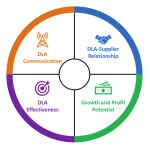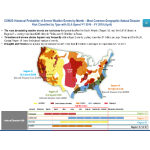Proven Success
Case Studies
SHEPRA, Inc. has decades of experience supporting the government and private businesses in meeting their organizational goals.
Helping Clients Meet Their Goals
Incredible Success Stories Since 2007
Multi-Million Dollar Projects
Dynamic Multi-Disciplined Environments
Case Study - 01
Climate and Customer Survey Design, Management, and Analysis
DLA Supplier Satisfaction Survey
DLA HQs and Major Subordinate Commands (MSCs)

In 2018, DLA announced its plans to build stronger industry partnerships through its Industry Engagement Plan. One of its primary goals, Supplier Feedback Management and Advocacy, involves collecting data about supplier perceptions of DLA supply chain practices and developing action plans to address areas needing improvement. To that end, DLA commissioned a survey that would be distributed biennially to its suppliers across the Agency.
SHEPRA was tasked with developing and implementing a first-of-its-kind supplier satisfaction survey, as well as analyzing the data from survey responses and presenting the findings to DLA senior-level leadership.
SHEPRA’s team developed a survey and reporting model using industry, academia, and consulting best practices. SHEPRA compiled a participant list of 7,819 suppliers; initiated a data collection plan, including sample size, criteria, and demographics; and created visualizations of the survey results. Utilizing a cloud-based survey system, SHEPRA handled all aspects of survey management (e.g., survey design, branching logic, email distribution and invitations, completion status, reminder emails, and help desk support). Additionally, SHEPRA provided post-survey support to DLA MSC teams by facilitating work groups, conducting analysis and brainstorming workshops, defining action plans and improvement measures, and delivering executive briefings to HQ J7 to showcase survey results.
SHEPRA designed a customer satisfaction survey that has become instrumental in DLA’s mission to strengthen supplier partnerships. SHEPRA’s survey management expertise has yielded high supplier participation (38% in 2020), which is key to providing more substantial data for DLA to act upon. After the initial 2018 survey campaign, SHEPRA won the contract to continue survey management for 2020, 2022, and 2024. This extended partnership with DLA has allowed SHEPRA to continuously improve the survey by incorporating past respondent feedback and addressing current acquisition challenges (e.g., supply chain disruptions and inflation related to Covid-19).
Case Study - 02
U.S. Industrial Capacity Identification and Expansion
Personal Protective Equipment (PPE)
DLA Medical, Troop Support

Frontline healthcare workers were experiencing critical shortages for N95 Masks and other PPE. Additional U.S industrial capacity was needed for critical PPE and prioritization over China made products.
SHEPRA was tasked to evaluate the industrial capacity of the U.S. N95 supply chain and the nonwoven materials, perform an industrial base analysis, document potential manufacturers, identify component raw materials, and manufacturing methods required for production. SHEPRA also identified U.S. industrial base risks and potential barriers to market entry.
SHEPRA identified U.S. and global industrial base risks, barriers to U.S. company manufacturers, component material limitations, opportunities for U.S. manufacture to increase production and enter the market. SHEPRA identified U.S. companies capable and willing to manufacture N95 masks and other PPE. Conclusions and recommendations were developed, allowing an expansion in U.S. capabilities.
SHEPRA successfully identified and assessed 149 nonwoven companies, textile mills, nonwoven manufacturers, converters, and distributors. A total of 30 companies demonstrated manufacturing characteristics linked to quality and performance of PPE, including N95. The study provided a detailed flow perspective on critical processes used by the top ten companies manufacturing the fabric, and potential expansion capacity within this critical U.S. industrial base.
Case Study - 03
Predictive Risk Assessment and Mitigation
U.S. Defense Protection Act Usage for COVID-19 Response
Office of Secretary of Defense (OSD) and DLA HQs

Defense Production Act funded targeted investments of the industrial base in support of COVID-19. The DLA HQs Industrial Capability Program (ICP) tasked SHEPRA to support OSD’s strategy development and associated research required to engage in U.S. Industrial Base Expansion (IBx) investments to create and/or expand domestic capability for key COVID-19 response materials.
SHEPRA supported IBx efforts by providing analytical, technical, and strategic support directly to the DPA Task Force. This support included market research, IBx proposal review, interagency coordination, industrial capability data analysis, requirements analysis, and other strategic decision support.
SHEPRA assisted OSD and DLA HQs in the creation of Request for Information (RFI) documents for DPA grant proposals as well as “artifact” documents detailing all research and analysis supporting specific investment decisions. SHEPRA staff coordinated multiple events, produced briefings and white papers detailing capability preservation strategies, and provided analyses of future market environments do not support expanded industrial capability.
SHEPRA successfully supported the OSD DPA Task Force and DLA HQs in facilitating approximately $628M in IBx projects obligated by September 1, 2020 with more projects planned for award through October 2020.
Case Study - 04
Supply Chain Analysis and Risk Mitigation
Global Strategic Minerals Supply Chain Analysis: Cesium
Defense Logistics Agency: Land & Maritime

China has a near monopoly on a very strategic and rare earth material: Cesium, which helps form the backbone of existing technologies in medical, communication, defense, and space applications. North American reserves exceed U.S demand, but that is diminishing. The U.S. needs to identify Cesium supply chain sources to avoid sourcing issues with China.
SHEPRA was tasked to identify North American sources of Cesium, recommend strategic controls to assure U.S. sources of supply, and look for new North American sources. Additionally, evaluate mining and refining characteristics, recycling issues, consumption, cost issues and market applications.
SHEPRA identified global and U.S. sources, distribution channels, mining and refining characteristics, and predictive growth and usage trends. New potential sources were identified within North America. Supply chain and military risks were uncovered, and avenues for securing Cesium supplies for the U.S. identified. Conclusions and recommendations were issued to DOD.
SHEPRA successfully identified and recommended several new potential sources of Cesium, a process for recycling Cesium materials, and a strategic approach to mitigate existing and potential supply chain risks. The study provided a detailed flow perspective on critical sources and processing characteristics for a complete understanding of Cesium sourcing and consumption trends.
Case Study - 05
Severe Weather Damage Impact Predictive Assessment
Severe Weather Natural Disaster Impact Risk Analysis
Defense Logistics Agency – HQs

Critical defense supply chain infrastructure is subject to natural disaster risks (i.e., hurricanes, flooding, earthquakes) that can impact warfighter readiness and lethality. Potential impact and vulnerability analyses was required as critical materials and parts manufacturers, particularly sole or single source vendors, have experienced production disruptions due to flooding, utility service interruptions, and transportation infrastructure damage.
A supply chain risk assessment and mitigation tool structure for the defense industry supply chain was developed to predict disruptions impacting Warfighter readiness and nimbleness. Planning for potential interruptions using predictive analytics to define a Probabilistic Risk Assessment (PRA) matrix provides for rapid response capabilities. This assessment was focused on the development of a decision-making tool available to Major Subordinate Commands (MSC) and other stakeholders. Developed and recommended a visual dashboard with monitoring and assessment capability to evaluate potential risks of disruption to the supply chain.
SHEPRA documented a history of U.S. and global industrial base risks due to severe weather events, as well as severe weather damage costs to the supply chain industrial base, as well as readiness risks and costs to DoD and the warfighter. Identified Supply chain vulnerabilities, with alternative sources of supply were identified with a risk profiles by vendor dependent on geographic location and DoD critical parts requirements. Potential impacts to the industrial base were categorized and communicated to the various MSCs. Conclusions and recommendations were developed, allowing for risk mitigation strategies for industrial base stabilization of critical parts during severe weather events.
SHEPRA successfully developed a Natural Disaster Monitoring and Risk Assessment Tool (NDMRA) predictive analytics tool structure. This tool will be used as a rapid response and decision-making mechanism for the MSCs incorporating data residing in the MilCloud 2.0 infrastructure, NOAA and National Weather Service (NWS) predictive weather models and alert systems in a data warehouse central repository to integrate the data. The system will have an extract, transform, load (ETL) layer for data integration and storing.
Case Study - 06
Malaria Drugs Pharmaceuticals
U.S. Army Medical Materiel Development Activity (USAMMDA)
DLA Troop Support Medical Directorate

In March of 2021, the U.S. Army Medical Materiel Development Activity (USAMMDA) required support for future Malaria drug pharmaceuticals. Two new drugs were available for acute critical care for the prevention and treatment of malaria. Having access to these critical drugs in Malaria endemic areas of the world is vital for support of the DoD. The DLA Troop Support Medical Directorate requested review of USAMMDA efforts to ensure supply availability access to these primary Malaria drugs: Malaria Prophylaxis Drug-Tafenoquine (Arakoda) and the Malaria Treatment Drug-Intravenous Artesunate®.
The Industrial Capability Warstopper Program and Shepra Inc. were tasked to evaluate the capacity within the U.S. malaria supply chain and provide a global supply chain analysis. The task required an industrial base analysis, to include an analysis of the manufacturers’ key production processes, identifying constraints, critical components and raw materials needed to manufacture the malaria drugs.
Shepra Inc. engaged DLA, USAMMDA and the Malaria drug suppliers in a study to determine and document risk within the U.S. and global industrial base supporting each supply chain and its manufacturing processes. The analyses included U.S. required agency compliance and oversight by the Center for Disease Control and the Food and Drug Administration approval process including clinical trials, ongoing testing and protocols required for the launch and sustainment of a new drug.
Shepra identified and assessed key supply chain inputs and outputs, including documenting key processes and suppliers for components. The analysis determined both supply chains are maturing, with expectations for increased demands over the next two years. The U.S. companies supporting the malaria drugs were noted to provide services to include secondary packaging, specialized micronization and sterilization procedures, storage, and distribution. The study identified potential for increasing capacity within this critical U.S. industrial base.